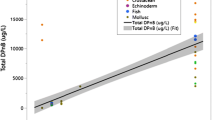Abstract
Our purpose was to determine if the acute and sub-lethal effects of fog oil, an obscurant used for military training, could be observed in realistic field exposures. To this end, we exposed Daphnia magna to oil fogs under actual release conditions at a U.S. Army training site. Guided by field investigations, acute toxicity experiments were conducted in the laboratory with the more sensitive species Ceriodaphnia dubia to test the hypothesis that dissolution of fog oil constituents into water is minimal and actual contact by organisms with the water surface is required to cause toxicity. We conducted further experiments to test the hypothesis that vaporization of fog oil alters its chemical composition and toxicity to freshwater invertebrates. In the field, daphnid mortality was minimal more than 5 m from the point of fog generation, but sub-lethal effects were more extensive. Both field and laboratory experiments suggested that physical contact with oils on the water surface was the most important factor driving toxicity. To our knowledge, this is the first attempt to evaluate toxicological endpoints with freshwater invertebrates in field exposures with fog oil.


Similar content being viewed by others
References
Ankley GT, Collyard SA, Monson PD, Kosian PA (1994) Influence of ultraviolet light on results of toxicity tests conducted with sediments contaminated with polycyclic aromatic hydrocarbons. Environ Toxicol Chem 13:1791–1796
Barron MG, Carls MG, Short JW, Rice SD, Heintz RA, Rau M, DiGiulio R (2005) Assessment of the phototoxicity of weathered Alaska North slope crude oil to juvenile pink salmon. Chemosphere 60:105–110
Boese BL, Lamberson JO, Swartz RC, Ozretich R, Cole F (1998) Photoinduced toxicity of PAHs and alkylated PAHs to a marine infaunal amphipod (Rhepoxynius abronius). Arch Environ Contam Toxicol 34:235–240
Bowling JW, Leversee GJ, Landrum PF, Giesy JP (1983) Acute mortality of anthracene-contaminated fish exposed to sunlight. Aquat Toxicol 3:79–90
Cleveland L, Little EE, Calfee RD, Barron MG (2000) Photoenhanced toxicity of weathered oil to Mysidopsis bahia. Aquat Toxicol 49:63–76
Diamond SA, Milroy NJ, Mattson VR, Heinis LJ, Mount DR (2003) Photoactivated toxicity in amphipods collected from polycyclic aromatic hydrocarbon-contaminated sites. Environ Toxicol Chem 22:2752–2760
Douglas TA, Johnson JB, Collins CM, Reynolds CM, Foley KL, Perry LB, Gelvin AB, Hardy SE (2006) Assessing fog oil deposition to simulated plant surfaces during military training. A423854. Engineering Research and Development Center, Hanover, NH, Cold Regions Research and Engineering Laboratory
Driver CJ, Ligotke MW, Galloway-Gorby H, Dennis G, Reinbold K (2002a) Acute inhalation toxicity of fog oil smoke in the red-winged blackbird, a size-specific inhalation surrogate for the red-cockaded woodpecker. ERDC/CERL TR-02-6. Engineer Research and Development Center, Construction Engineering Research Laboratory, Champaign, IL, USA
Driver CJ, Ollero J, Su YF, Fulton R, Dennis G, Tiller B, Balbach H, Reinbold K (2002b) Effects of fog oil smoke on the hatchability and fledgling survival of the house sparrow (Passer domesticus), a nestling surrogate for the red-cockaded woodpecker. ERDC/CERL TR-02-34. Engineer Research and Development Center, Construction Engineering Research Laboratory, Champaign, IL, USA
Hamilton MA, Russo RC, Thurston RV (1977) Trimmed Spearman-Karber method for estimating lethal concentrations in toxicity bioassays. Environ Sci Technol 11:714–719
Katz S, Snelson A, Butler R, Farlow R, Welker R, Mainer S (1980) Physical and chemical characterization of military smokes. Part 2: Fog oils and oil fogs. AD-A093205. IIT Research Institute, Chicago, IL, USA
Langford RE (2004) Introduction to weapons of mass destruction: radiological, chemical, and biological. Wiley-Interscience, Hoboken, NJ
Little EE, Cleveland L, Calfee R, Barron MG (2000) Assessment of the photoenhanced toxicity of a weathered oil to the tidewater silverside. Environ Toxicol Chem 19:926–932
National Research Council (NRC): Committee on Toxicology—Subcommittee on Military Smokes, Obscurants (1997) Toxicity of military smokes and obscurants, vol 1. National Academy Press, Washington, DC
Peachey RBM (2005) The synergism between hydrocarbon pollutants and UV radiation: otential link between coastal pollution and larval mortality. J Exp Mar Biol Ecol 315:103–114
Pelletier MC, Burgess RM, Ho KT, Kuhn A, McKinney RA, Ryba SA (1997) Phototoxicity of individual polycyclic aromatic hydrocarbons and petroleum to marine invertebrate larvae and juveniles. Environ Toxicol Chem 16:2190–2199
Poston TM, McFadden KM, Bean RM, Clark ML, Thomas BL, Killand BW, Prohammer LA, Kalkwarf DR (1986) Acute toxicity of smoke screen materials to aquatic organisms, white phosphorous-felt, red phosphorous-butyl rubber, and SGF No. 2 fog oil. AD-A167-900. Pacific Northwest Laboratory, Richland, WA, USA
Poston TM, Bean DR, Kalkwarf BF, Thomas BL, Clark ML (1988) Photooxidation products of smoke generator fuel (SGF) No. 2 fog oil and toxicity to Hyalella azteca. Env Toxicol Chem 7(9):753–762
Rubinoff J, Seksienski S, Woodson B, Wills T (2005) Installation summaries from the 2004 survey of threatened and endangered species. SFIM-AEC-TS-TR-2005008. U.S. Army Environmental Center, Aberdeen Proving Ground, MD, USA
Sall J, Lehman A, (1996) JMP start statistics. SAS Institute, Duxbury Press, Belmont, CA, USA
Singer MM, Aurand D, Bragin GE, Clark JR, Coelho GM, Sowby ML, Tjeerdema RS (2000) Standardization of the preparation and quantitation of water-accommodated fractions of petroleum for toxicity testing. Mar Pollut Bull 40(11):1007–1016
Sutton PA, Lewis CA, Rowland SJ (2005) Isolation of individual hydrocargons from the unresolved complex hydrocarbon mixture of a biodegraded crude oil using preparative capillary gas chromatography. Org Geochem 36(6):963–970
US Environmental Protection Agency (USEPA) (1993) Methods for measuring the acute toxicity of effluents and receiving waters to freshwater and marine organisms 4th edn. EPA/600/4-90/027F. Cincinnati, OH, USA
Von Stackleberg K, Amos C, Smith T, Cropek DM, MacAllister B (2004) Military smokes and obscurants: fate and effects. ERDC/CERL TR-04-29. US Army Corps of Engineers, Construction Engineering Research Laboratory, Champaign, IL, USA
Acknowledgment
Thanks to personnel at the Aberdeen Proving Ground, Aberdeen, MD and the Army Environmental Center. This work was supported by the Strategic Environmental Research and Development Program, project number SI-1332.
Author information
Authors and Affiliations
Corresponding author
Rights and permissions
About this article
Cite this article
Cropek, D.M., Esarey, J.C., Conner, C.L. et al. Toxicological effects of military fog oil obscurant on Daphnia magna and Ceriodaphnia dubia in field and laboratory exposures. Ecotoxicology 17, 517–525 (2008). https://doi.org/10.1007/s10646-008-0207-z
Received:
Accepted:
Published:
Issue Date:
DOI: https://doi.org/10.1007/s10646-008-0207-z




